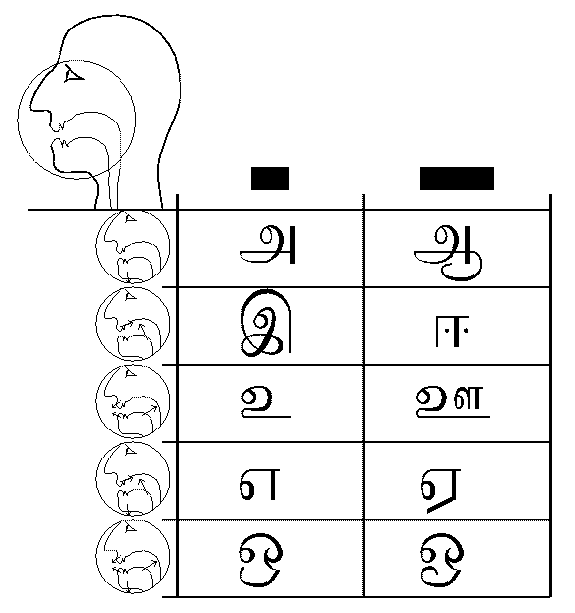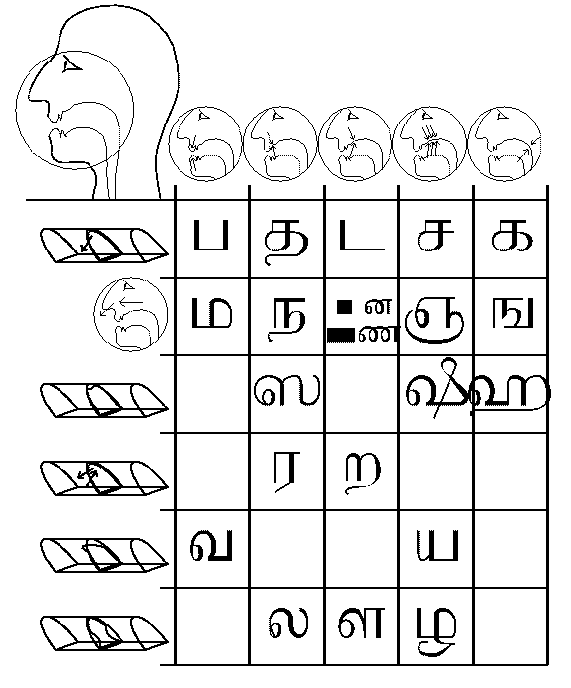Self-Study Literacy Materials
Literacy on a Sheet of Paper.A method for Tamil and other phonetic writing systems
Introduction
A new method is described and demonstrated here which may make it possible to deliver literacy education to a smart and motivated illiterate person at the cost of a sheet or two of paper, with little or no investment of time or explanation from a teacher. Field experiments are required to prove it out, but if this method is successful even for only a small percentage of recipients, it would be a practical and affordable way to bring literacy to millions.
The scale of the problem
Consider India, with an estimated 400 million illiterate people. Effective, free, public education is not widely available in India, and private teachers demand payments which most cannot afford. Given the scale of this problem, well-meaning people, organizations and governments are really helpless. It is impractical for resource-limited institutions to pay for or organize literacy development programs that can influence more than a few tens or, optimistically, hundreds of thousands of people. So the great mass of poor people in India, and elsewhere in the world, for that matter, have no way out of the illiteracy trap. This work aims to a practical solution to this dilemma.
The Idea
Linguists and phoneticians have traditionally used sound charts to relate letters or symbols to mouth positions and movements. Vowel and consonant charts are tables labelled with names of phonetic characteristics, such as "labial", "dental", and so forth, and they are universally used by students in introductory phonetics and phonology classes to learn the sound-symbol correspondence of the International Phonetic Alphabet. Here we will use similar charts as the basis for learning the sound-symbol correspondence, by making them understandable to illiterate people so they can associate their native language's sounds to the symbols of its alphabet.
How I thought of it
When I was visiting South India recently, since I'm a phonetician and a linguist, I made a small personal study of the Tamil language, which is spoken in the region I was visiting. I discovered what many already knew, that they do not make distinctive use of the voicing dimension. That is, they have no contrasts between /p/ and /b/, or between /s/ and /z/, or between /k/ and /g/, etc. Instead, they have a sound that is phonetically in-between our categories, and depending on the adjacent sounds it can sound more like our voiced sound or more like our unvoiced sound, but in Tamil this difference doesn't make a difference between words as it does in English and many other languages.That discovery got me to thinking, and I realized that the consonant chart for Tamil only needs two dimensions, not three, since voicing can be ignored. That means that a TWO dimensional table of sounds will fully represent the sounds of this language.
The usual consonant chart is a three-dimensional table. The dimensions are
- (1) the voicing state of the larynx (voiced or vibrating, and unvoiced or non-vibrating),
- (2) the place of constriction in the vocal tract (divided up into several places between the lips and the glottis), and
- (3) the manner of articulation (closure, grooved opening for whistling sounds like /s/ or /sh/, closure with an opening on the side as for /l/, and so forth).
How it works
The two insights, of having a two-dimensional chart for sounds and using pictures as the labels of the columns and rows, are the basis of this new method. No literacy skills are required for a reasonably intelligent and illiterate person to interpret such a table. All one needs to know is that the tables represent the sounds for each letter, and then one can figure out the rest entirely alone.The arbitrary sound-symbol correspondence is the biggest obstacle in literacy. Without knowing in detail the elements of that unpredictable, impossible-to-guess, correspondence, it is completely impossible to read or write. But if you know that much, you can at least sound out the letter sequences, and thereby figure out the words that they represent (for words you happen to know).
And until now, without the commitment of a teacher or other expensive methods to teach that correspondence, there is no way for an illiterate person to learn it. THIS is the main problem; everything else is a footnote.
In short, a completely illiterate person should be able to to understand these charts, and learn the letter-to-sound correspondences, without any previous knowledge of how to read. Since that arbitrary correspondence is in itself the primary obstacle to basic literacy, a single sheet of paper, along with a one-minute explanation of the purpose of it and how to interpret the charts, may be all the outside intervention that a motivated and intelligent but illiterate person needs in order to figure out how to read.
Limitations
Literacy also includes other skills:- knowing how to hold, use, and draw letters with a pen or
pencil.
- but one can figure this out alone.
- knowing that sequences of letters represent sequences of
sounds and that words are composed of sequences of sounds.
- One could also figure this out alone; on the other hand, explaining it should take less than a minute.
- knowing the idiosyncrasies of a writing system
in which the spelling doesn't determine the pronunciation
or vice versa.
- Most languages are relatively phonetic, like Spanish (where you write it like you say it), rather than inconsistently phonetic, like English (where it's hard to know how to spell many words), or non-phonetic, like Chinese (where symbols represent words instead of sounds). This method will work best with consistently phonetic written languages; not so well with inconsistently-phonetic written languages; and not at all with non-phonetic languages.
- learning written vocabulary that is not part of the
native spoken vernacular.
- Many languages do not have a distinct literary form, though those with a long literate history normally do. For the former this problem doesn't exist; for the latter, it is usually a life-long learning process for most speakers of that language anyway, and while we don't deliver a full packaged curriculum solution here, we do get them started with basic tools which will let them begin to learn unknown words themselves, just as they learned their spoken vocabulary through experience and context and without consulting a dictionary or formal teacher.
In short, we do not attempt to provide full literacy, but only basic literacy skills. Despite this limitation, the method solves the central problem, which is enough to enable learners with absolutely no other educational resources to learn enough to read and write for themselves and to begin to understand and learn about more advanced literacy skills.
Implementation for Tamil
Since Tamil can be handled with a simpler consonant chart, using two dimensions instead of three, our first work is with Tamil. On a single sheet of paper can be printed the two tables displayed below (along with some enhancements discussed after the tables). These two tables relate the symbols of the language's alphabet to the positions and movements of the lips and tongue.- The first table is for vowels. For the rows, it shows the
jaw/tongue/lip movements associated with each of 5 vowel qualities.
For the columns it shows vowel length, indicated by a bar of shorter
or longer length.
- The second table is for consonants, and it shows "place of articulation" in columns, and "manner of articulation" in rows.
The drawings that label each row and column are clear enough to unambiguously pick out the sound associated with each symbol in the table.
Tamil speakers who do not know how to read should be able to figure out the sound-symbol relationships for their script by carefully studying these pictures and making the movements and sounds indicated.
Most people that I have shown these tables to, who are not Tamil speakers or readers, have been able to guess the sound associated with each symbol, on the first attempt, about half the time.
These pictures may provide all the information needed to figure out how to read, by oneself, without a teacher or any other assistance or support, simply by studying this puzzle-like document and figuring it out. Not every illiterate person can be expected to do this successfully, but the intelligent and motivated ones will succeed, and they will be able to teach others.
By following this plan, it is not unreasonable to hope that a
significant percentage of the world's illiteracy problem can cheaply
and quickly be overcome. Not every illiterate person will be able to
puzzle it out, but a significant percentage will be able to, and each
one who does can teach others, using the same document.
This project needs help with these additional items:
Vowels

Consonants

Enhancements
Three enhancements will complete the puzzle of the Tamil alphabet.
Three additional enhancements will make it easier to figure it out.
The above items complete the coverage of the information content
of the Tamil script. Three additional items, below, will help to
ease the task of learning and memorization for students.
Potential Problems
To do:
How You Can Help
Please help us to make this vision a reality. See our funding proposal
for the validation experiments. One way you can contribute is to help
validate the method by visiting the Tamil
Alphabet Puzzle and giving your guess of what English sound is
closest to each of the various symbols. Your guesses will help us
evaluate how well the system works. (In early data, >90% of submitted
answers have been correct, so guessing accuracy is indeed pretty
high.)
Of course if I go to Chennai I can probably solve these pretty
quickly, but here in the US, your help is the only way. Please contact
me! Praise and dialog is what gets me working on this. Your
suggestions and moral support are so precious!
This project also needs suggestions and contacts of people and institutions who can help in any part of it. Right now volunteer work doesn't seem to be getting things done too quickly. So I am seeking pilot-project funding to pay for art-work, linguists, testing, and distribution, basically to send myself to India to do some experiments and come back and write it up, before scaling it up to be a large-scale delivery project.
Credits
- Initial concept and implementation are due to Tom Veatch.
- The font system, itrans, was built by Avinash Chopde.
- The Tamil fonts used in itrans were made by Thomas Ridgeway.
- The web interface to the Tamil font generator was built by Hari Adiseshu.
- The "a for apple" idea was contributed by Mary Veatch.
- The Tamil alphabet puzzle idea for validation of the concept via web forms was contributed by Michelle Effros.
